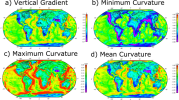Thank you for sharing the session. I was very curious about Gregorian chant, and there appears to be some pdf files of old books on this page. Gregorian chant books There is also a page for Gregorian chant sheet music: Gregorian Chant Sheet Music Downloads at Musicnotes.com
Regarding the unusual earth quake:

The distance from Mayotte to Pemba in Mozambique is around 490 and straight East to Madagascar is 420 km
For comparison according to the Wiki, Lake Superior covers 82.000 km^2 that is 286 km by 286 km. The article continues:
Here is an introduction to the project investigating the gravity field of the Earth, where there are also links to videos, images and downloads.
Introducing GOCE
The following picture is from Figure 1: | Scientific Reports found on Earth tectonics as seen by GOCE - Enhanced satellite gravity gradient imaging
Figure 1
From: Earth tectonics as seen by GOCE - Enhanced satellite gravity gradient imaging[/QUOTE]


Regarding the unusual earth quake:
There was this article from National Geographic Strange waves rippled around the world, and nobody knows why(Pierre) What was the cause of this monochromatic earthquake that lasted 20 minutes last month off the coast of Madagascar?
A: Grand chamber collapse deep underground. Like a deep sinkhole. And extremely large!!!
Q: (Joe) They were saying they thought it was an undersea volcanic eruption.
(L) So what caused it?
A: Combination of factors including crustal slippage and magnetic field anomaly. Check gravity graphic for the region for clues.
Q: (L) That must mean that globey thing they made that shows the shape of the Earth according to its gravity.
(Pierre) I would guess the anomaly shows a weak gravity so there'd be less binding force there.
(L) So it doesn't have anything to do with the sun...
(Andromeda) That trembling was on the 18th, and a week later the sun did the singing.
(L) The sun was singing.
A: Loosely connected by effects of the same general influences in the solar system at present.
The article has this map:Strange waves rippled around the world, and nobody knows why
Instruments picked up the seismic waves more than 10,000 miles away—but bizarrely, nobody felt them.
BY MAYA WEI-HAAS
PUBLISHED NOVEMBER 28, 2018
On the morning of November 11, just before 9:30 UT, a mysterious rumble rolled around the world.
The seismic waves began roughly 15 miles off the shores of Mayotte, a French island sandwiched between Africa and the northern tip of Madagascar. The waves buzzed across Africa, ringing sensors in Zambia, Kenya, and Ethiopia. They traversed vast oceans, humming across Chile, New Zealand, Canada, and even Hawaii nearly 11,000 miles away.
The distance from Mayotte to Pemba in Mozambique is around 490 and straight East to Madagascar is 420 km
For comparison according to the Wiki, Lake Superior covers 82.000 km^2 that is 286 km by 286 km. The article continues:
Next the issue was to find a map showing anomalies in the gravity field around the globe.These waves didn't just zip by; they rang for more than 20 minutes. And yet, it seems, no human felt them.
Only one person noticed the odd signal on the U.S. Geological Survey's real-time seismogram displays. An earthquake enthusiast who uses the handle @matarikipax saw the curious zigzags and posted images of them to Twitter. That small action kicked off another ripple of sorts, as researchers around the world attempted to suss out the source of the waves. Was it a meteor strike? A submarine volcano eruption? An ancient sea monster rising from the deep?
“I don't think I've seen anything like it,” says Göran Ekström, a seismologist at Columbia University who specializes in unusual earthquakes.
“It doesn't mean that, in the end, the cause of them is that exotic,” he notes. Yet many features of the waves are remarkably weird—from their surprisingly monotone, low-frequency “ring” to their global spread. And researchers are still chasing down the geologic conundrum.
Here is an introduction to the project investigating the gravity field of the Earth, where there are also links to videos, images and downloads.
Introducing GOCE
Launched on 17 March 2009, ESA's Gravity field and steady-state Ocean Circulation Explorer (GOCE) mission was the first Earth Explorer mission in orbit.
This novel mission delivered a wealth of data to bring about a whole new level of understanding of one of Earth's most fundamental forces of nature – the gravity field.
This sleek, high-tech gravity satellite embodied many firsts in its design and use of new technology in space to map Earth's gravity field in unprecedented detail.
As the most advanced gravity space mission to date, GOCE data are realising a broad range of fascinating new possibilities for oceanography, solid Earth physics, geodesy and sea-level research, and significantly contributing to furthering our understanding of climate change.
Although invisible, gravity is a complex force of nature that has an immeasurable impact on our everyday lives. It is often assumed that the force of gravity on the surface of Earth has a constant value, but in fact the value of 'g' varies subtly from place to place.
The following picture is from Figure 1: | Scientific Reports found on Earth tectonics as seen by GOCE - Enhanced satellite gravity gradient imaging
I still have not understood completely what for instance "minimum Curvature" is, but at least the maps convey that the Earth is much more uneven place then we learn in the classical high school book on physics.Curvature components at GOCE satellite altitude
Figure 1 shows the main curvature components and for comparison the vertical gravity gradient at satellite height of 225 km. In all components, the oceanic and continental domains are clearly differentiated. Within the continental areas the main tectonic elements, such as cratons and their boundaries and major orogenic belts are clearly imaged. The mean curvature shows the same features as the vertical gradient, as expected (see formula in the Methods section). The minimum and maximum curvature, however, illustrate the internal structure of the continents and oceans more clearly than the vertical gravity gradient. For example, internal differences within the continents are more readily apparent in the maximum curvature.
Figure 1
From: Earth tectonics as seen by GOCE - Enhanced satellite gravity gradient imaging[/QUOTE]
Global plots of curvature attributes. (a) Vertical Gradient (b) Minimum Curvature, (c) Maximum Curvature, (d) Mean Curvature. A: Andes, C: Cordillera, CC: Congo Craton, EE: East European Craton, HI: Himalaya, K: Kaapvaal Craton, SL: Slave Craton, WA: West African Craton.
Below is Fig 2aThe more detailed structure within the continents is even better illustrated in the shape index shown in Fig. 2a. The values of the shape index can be expressed as dome- to bowl-like structures that the equipotential surface follows as an expression of a mass surplus or deficit at depth17. Bowl-shaped mass deficits correlate, in general, with orogenic belts and cratonic areas. For example, in the continental US, the cratonic core features a smaller mass deficit compared to the Cordillera in the west. This is expected, as for orogenic belts isostatic support in form of a crustal root is often observed (see also Himalaya). In contrast, mountain ranges associated with recent subduction zones like the Andes feature valley-like shape index structures, likely due to the mass surplus of the subducting slabs.
Perhaps the above maps can help to locate the issue the C's mentioned? One may have to take a close look at the maps and perhaps find out if there are some old extinct vulcanoes possibly super vulcanoes in the area,Notably, our new curvature products and especially the shape index vary quite significantly between individual cratons. Cratons are the oldest part of the continental crust and their seismological signatures are in general relatively similar, as expressed in the tectonic regularisation18 and crustal thickness maps19 (Fig. 2b,c).
Attachments
Last edited:





 ) in 1255 and became the capital of the 'State of The Teutonic Order' for a while under the then Prussian name "Konigsberg"
) in 1255 and became the capital of the 'State of The Teutonic Order' for a while under the then Prussian name "Konigsberg" 


 .
.